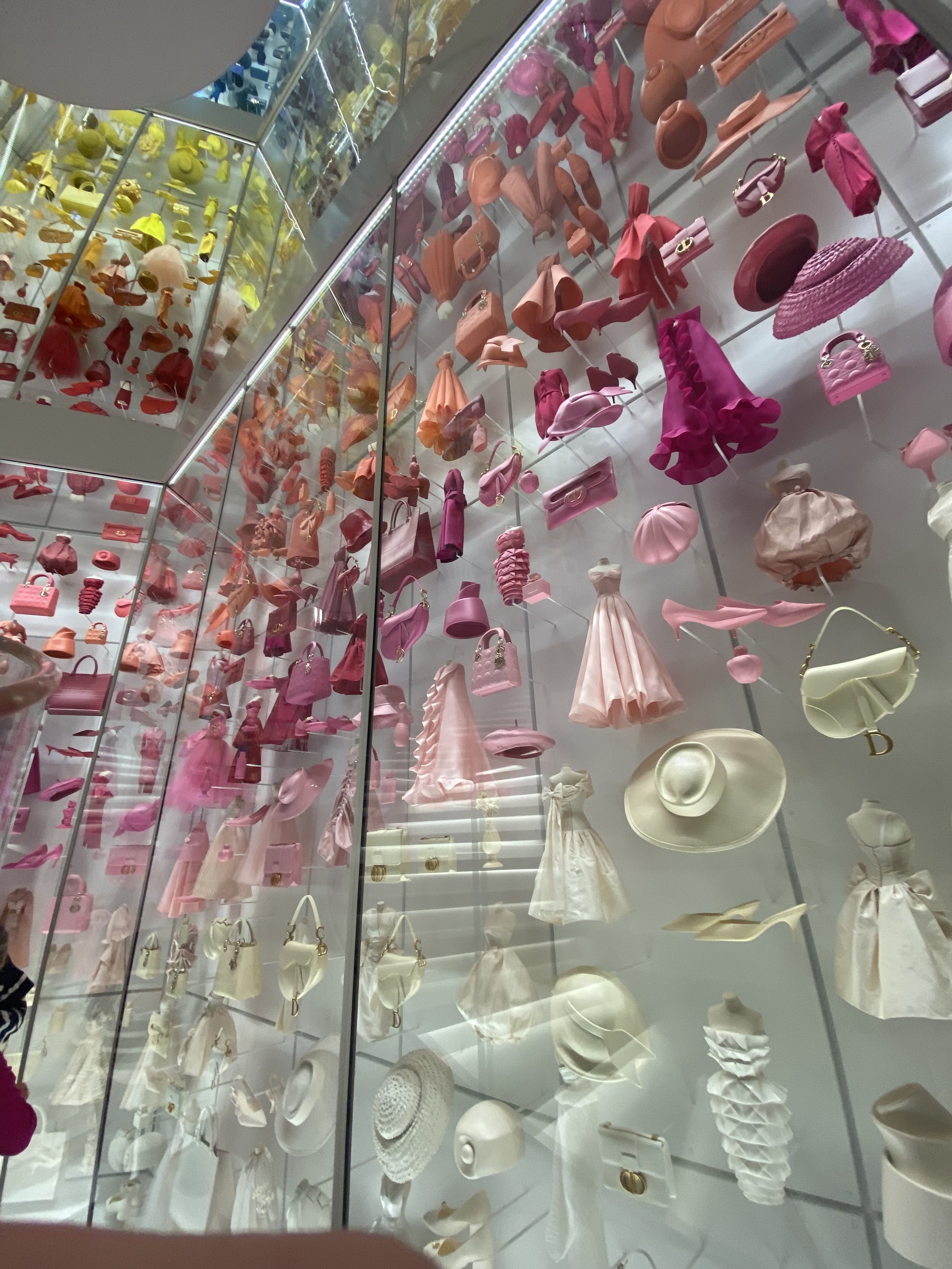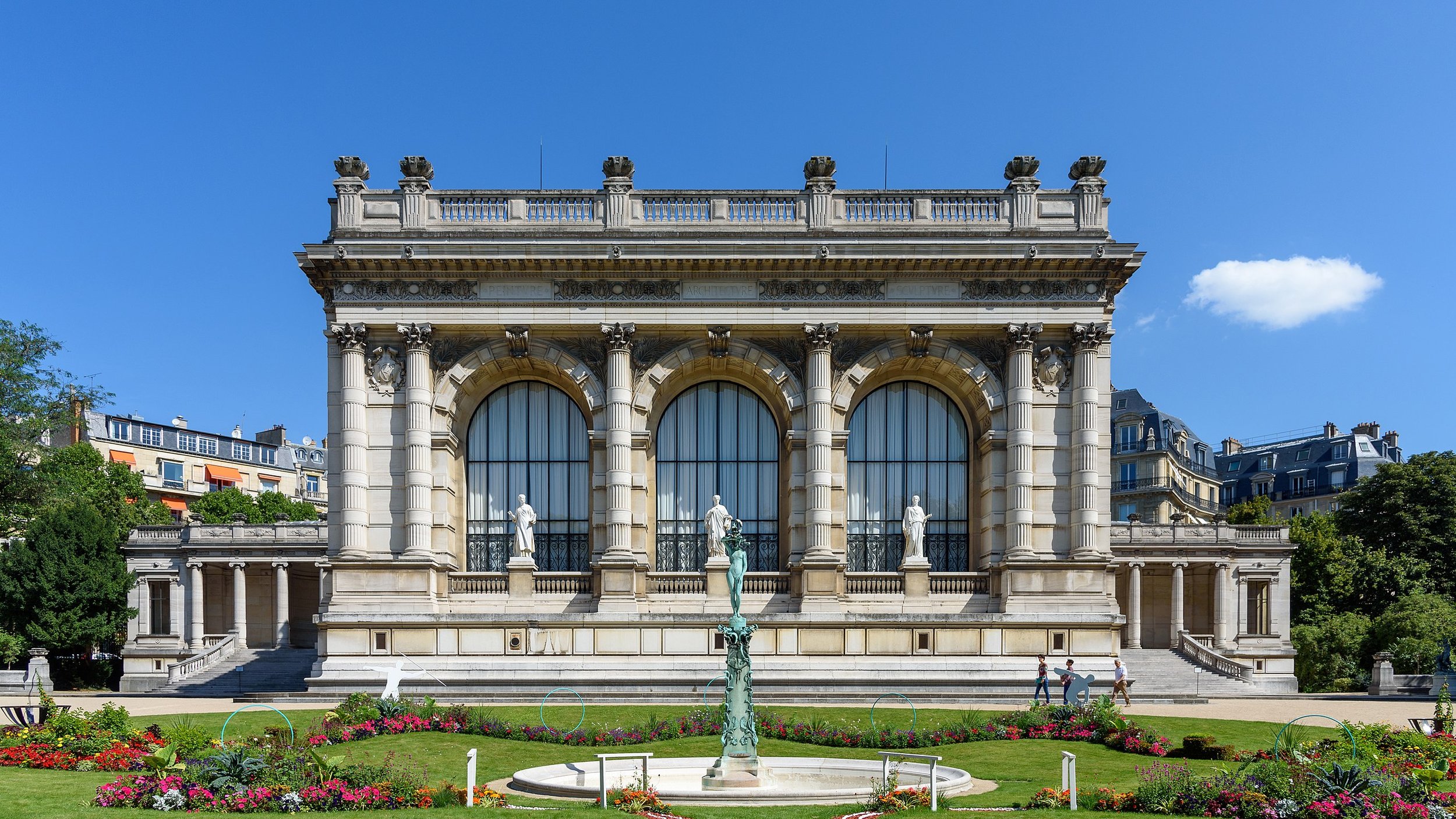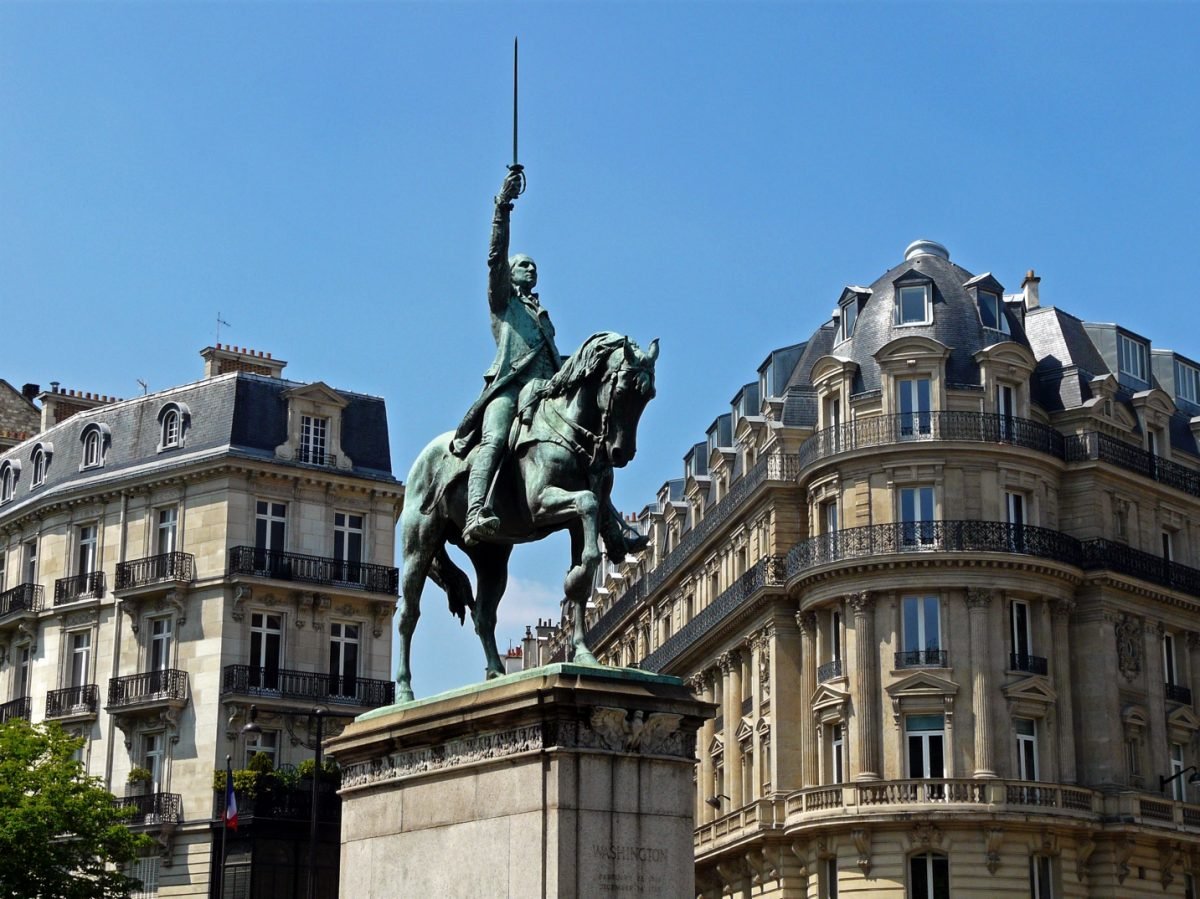Live from Paris, Sunday, July 31
The Fashion and Passion of the 16th
We start today’s walk outside the Galerie Dior, the newest treasure on the museum landscape of Paris. Housed in the building that was once home to Baron Hans von Bleichroder who came from a very wealthy banking family. He moved into Rousseau’s 1897 building in 1910 but it was an event three years later that would stick with him.
At the start of September 1913, Princess Sophie of Saxe-Weimar paid a visit to Paris with her mother to see Bleichroder. On September 13 on a drive through Fontainebleau, their car hit a child and injured them. The princess and her mother fled back to Warsaw and as the heat increased Bleichroder said the young princess had been driving the car. Distraught at the attention on September 17, 1913, back in her bedroom of the palace in Warsaw she shot herself and died.
The next-door neighbor at number 13, was once the home of Martine Marie Pol de Béhagne, countess of Bérn. Martine was the daughter of Octave de Béhague who was a very wealthy art collector. In 1890 she married Rene Marie Hector de Béarn and by 1920 the two ended in a divorce. After her parents died she used her vast inheritance to purchase this home as well as renovate her parents' palace on rue Saint Dominique in 1888.
Just at the corner and what is now connected to no 11 & 13 is the Dior flagship store at 30 avenue Montaigne. As soon as Christian Dior saw the building he knew it had to be his. On December 16, 1946, his dream came true. The building has another interesting history and a tie to Napoleon. In 1865 Alexandre Walewski, the first child and illegitimate son of Napoleon Bonaparte had it built but died before it was finished. His wife moved until it was sold and became known as the Hotel de Millon d’Aily de Verneuil.
Further down the street at no 24, Alfred and Lucie Dreyfus lived just after they were married on April 18, 1890. However, most of the street was dominated by the wealthy bankers of the 19th century that led way to the tv and radio offices and then haute couture houses.
No 44 was also built by Walewski and where they lived before the Dior building was finished. Today it has been the office for Balmain since 1952.
Taking a left onto the rue Pierre Charron and then to Avenue George V. Of course the name of the street makes you think of the Four Seasons George V with its amazing flower displays by Jeff Leatham.
George V is somewhat new to the landscape in Paris, but then again anything that is mid-19th century to me is new in the grand scheme of Parisian history. In 1928 André Terrail of La Tour d’Argent and Georges Wybo took on the design of a new luxurious hotel funded by American Joel Hillman. On October 24, 1929, Black Thursday, when he lost all his money he was forced to sell his hotel. Francois Dupré was next up as owner in 1931 and added on an additional wing that was used as apartments with a one-year lease with all the luxury of a hotel. A few other owners passed through until 1997 when the current owner took the reigns. Prince Alwaleed of Saudi Arabia managed on his own until he asked the Four Seasons to step in and take over. Today the 244 hotel rooms start at 1900€ a night.
The avenue gets its name from the English king, George V who ruled from 1865-1936. Just down the way at no 23 is the Amerian Episcopal church, Holy Trinity. The Greek Revival eglise was designed by British architect George Edmund Street and constructed in 1881. The spire was added on in 1904 and designed by the original architect’s son, Arthur Edmond Street. One of my favorite depictions of the church is the painting by Jean Béraud in the Musée d’Orsay, of all the fancy people leaving the church after a Sunday service.
At number 15, the Hotel Wagram was built in 1869 and was once home to Berthe de Rothschild after her marriage to Alexandre Berthier the 3rd prince of Wagram. Her son amassed an amazing collection of art including Monet, Renoir, and van Gogh before it would become the Spanish Embassy in 1920.
For those of you wanting a late night out in Paris on the sexier side add the Crazy Horse to your itinerary. Opened May 19, 1951, the mix of an American striptease club and exotic dance came along long after the Moulin Rouge and the other pioneers shocked Paris. In 1954 Miss Candida started her popular routine of taking a bath on stage which she would do more than 500 times. Dita von Teese and even Pamela Anderson have also graced the stage amid the all-nude review.
At the end of the street, we find the busy intersection of Alma-Monceau. The Eiffel Tower is in sight and the flame of the Statue of Liberty is just below.
Near the start of Avenue Monceau is the Musée Yves Saint Laurent, a small museum you don’t want to miss. Yves Saint Laurent worked at Dior from 1955 and took over as a designer after the death of Christian Dior in 1957. Leaving the house he started his own and exhibited his first collection on January 29, 1962. The 60th anniversary has been marked with small exhibits in six of the museums of Paris including the Louvre which is still on display until September.
In 1974, YSL moved his office to this location and worked here until he announced his retirement on January 7, 2002. The same year YSL and his partner created the Pierre Bergé and Yves Saint Laurent Foundation. On June 1, 2008, Yves Saint Laurent took his last breath losing his battle with brain cancer. Pierre died nine years later on September 8, 2017. The museum was opened and inaugurated the same month. Inside it is rather small but with two very well done special exhibits a year as well as a glimpse inside the former office of the fashion genius just as he left it.
Open Tuesday - Sunday 11 am - 6 pm and until 9 pm on Thursdays.
Left on rue Léonce Reynard to Rue de Galliera and the Palais Galliera. Marie Brignole Sale de Ferrari de Galliera was born in Italy in 1811, Her father fell in love with Paris and served as an ambassador and also a minister of state under Napoleon. Marie was married off to Raffaele de Ferrari in 1828 but her affection for Paris couldn’t keep her in Italy long. She left her husband behind and headed back to Paris. In 1878 Marie offered the city of Paris a plot of land and an offer to build a palace to hold her art collection. Deals were signed and architect Léon Ginain designed a small palace but things turned sideways when Clemenceau backed a new law targeting immigrant descendants that stayed in France. She tried to pull out of the deal but it was too late. She returned to Genoa with her art collection that was no longer intended as a gift to France. In 1888 she died, never to see her finished palace.
In 1895 it opened as a temporary exhibit space and in 1902 a contemporary industrial art museum. In 1920 it opened as the first fashion museum in Paris and the current incarnation opened in 1977. The inner frame structure was designed by the Eiffel Tower company and today you can look up and admire it as you stroll the special exhibits.
Open Tuesday to Sunday 10 am to 6 pm, Thursday until 9 pm.
Just off the back of the Palais Galliera is the Square of the same name filled with lovely statues. In the center of the fountain is Avril by Pierre Roche created in 1916. In the right corner are the God Pan and a Tiger by Just Bacquet in 1899 as a monument to Francois Rude.
Under the peristyles of the Palais are Protection and Future by Honoré Picard and On the Evening of Life by Gustave Michel. Don’t miss the allegories of Paintings by Henri Chapin, Architecture by Jules Thomas, and Sculpture by Pierre Cavelier on the center facade of the museum.
Across the street is the Musée d’Art Moderne Paris housed in the Palais de Tokyo. Built for the 1937 exhibition of arts and techniques to turn into a modern art museum. The MAM opened in 1961 and includes art created after 1905. Picasso, Modigliani, Matisse, Robert and Sonia Delaunay and Raoul Dufy. The pinnacle of the museum is the large Dufy painting La Feé Électricité painted in 1951 of 250 plywood panels stretching 33 by 20 feet around the oval room. It's amazing up close. Arrive first thing in the morning so you can get some great photos before people arrive.
In 2010 the most notable event struck the museum in the dark of night between May 19 & 20. For weeks the alarms were damaged and awaiting repair in parts of the museum and Vjeran Tomic working on behalf of art dealer Jean-Michel Corvey found out. In the middle of the night Spider-Man as Tomic was known, crawled through the window and stole five paintings. All but one were in the same room and chosen just because he liked them.
Picasso’s Dove with Green Peas was painted in 1912, Henri Matisse’s Pastoral in 1905, George Braque’s Olive Tree near Estaque in 1906, and Léger’s 1922 Still Life with Candlesticks. Modigliani's 1919 Woman with a Fan was in the next room. Guards were on duty but Tomic was able to get in and out pretty quickly and it wasn’t until the next morning that the paintings were discovered missing. Valued at over 1 million euros they were taken to copiest Yonathan Birn. When he heard the news of the arrest of his accomplices he tossed the five paintings in the trash. To this day they have never been recovered.
The museum is free except for special exhibits and is open Tuesday to Sunday from 10 am to 6 pm and until 9:30 pm on Thursday.
Outside along Avenue President Wilson, you can find one of the best outdoor markets in Paris on Wednesday and Saturday opening at 7 am and running until 1 pm on Wednesday and 3 pm Saturday.
Down the street, it’s hard to miss George Washington atop a horse charging into battle. The statue was inaugurated on July 3, 1900, and was a gift from the Daughters of the American Revolution in the US. American sculptor Daniel-Chester French was commissioned and had to also recreate the sword many times as soldiers kept stealing it.
Just off of the right shoulder of Washington is the Musée des Arts Asiatiques, known as the Guimet. Émile Guimet was a very wealthy collector of Asian antiques and collectibles. His father had created “Guimet Blue” which was the first artificial ultramarine blue and made a fortune for his family. Guimet’s collection became so large that he was able to split it between two museums he was building. The first in Lyon where he was born and then a second in Paris, Architect Jules Charron created the almost identical structures that are now filled with his amazing collection.
Open Wednesday to Monday from 10 am to 6 pm.
A few steps away on the Avenue d'Lena at number 11 was the home of Charles Ephrussi. Ephrussi was born in Odessa in 1849 and came from a very wealthy banking family. Charles was an art historian and critic and owned the Gazette des Beaux-Arts.
Charles was the uncle of Irene Cahen, wife of Moise de Camondo. It was a rocky marriage and she left him for another man after they had two children, Nissim and Béatrice. As a child, Irene was painted by Renoir and the painting was given to her daughter Béatrice. During both world wars, the Camando family was struck with one tragedy after another. At the end of the war, Béatrice and her family were killed by the Nazi and the painting fell into their hands.
One day Irene came across it in a museum and did all she could to get the painting back even saying it was the only reminder she had of her beloved daughter. Irene was a horrible mother and woman and after years in court, ownership of the painting was returned to her. She quickly turned around and sold it to controversial art collector Emil Buhrle. To know more about this story read the amazing book The House of Fragile Things by James McAuley.
We end this week's walk at the Square of Thomas Jefferson where we are greeted by the monument to the American Volunteers by Jean Boucher in 1923. At the far end, you will also find the bronze monument to George Washington and Lafayette by Auguste Bartholdi in 1895. In the center is a bust of Horace Wells the American who invented Nitrous Oxide and also Myron T Herrick who was the US Ambassador from 1912-1914.
The benches and street lamps were once a part of Battery Park in NY and trees from Ellis Island. If you need a little visit to America just visit the square of Thomas Jefferson.









